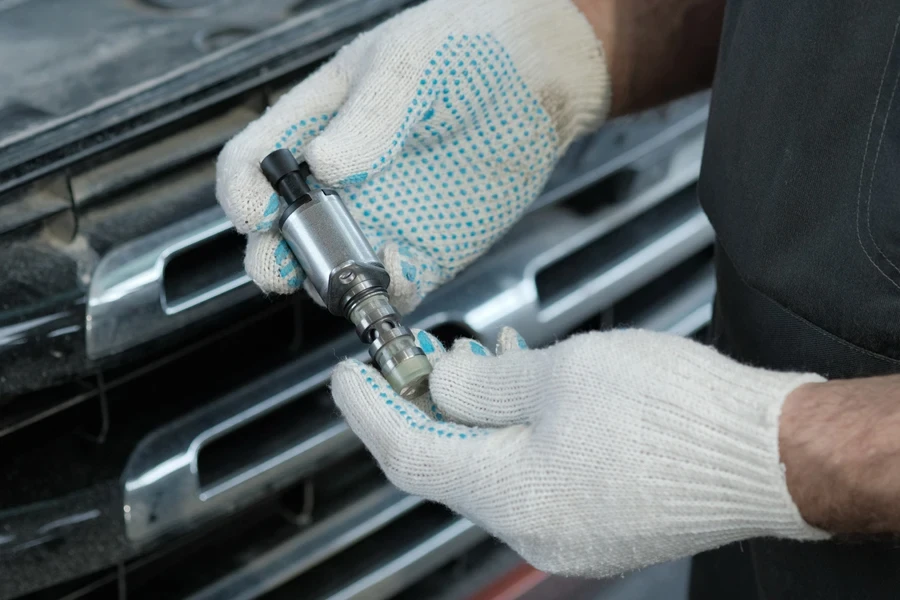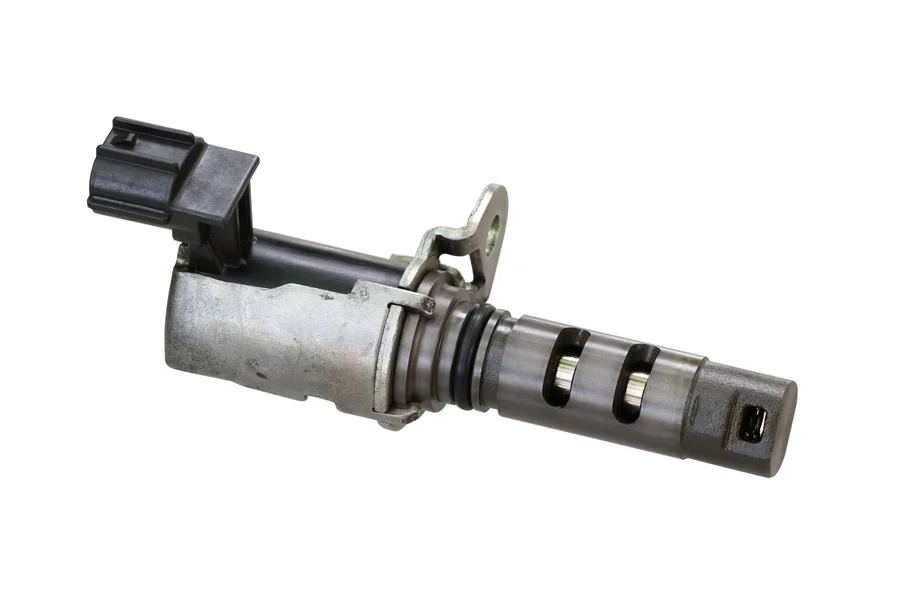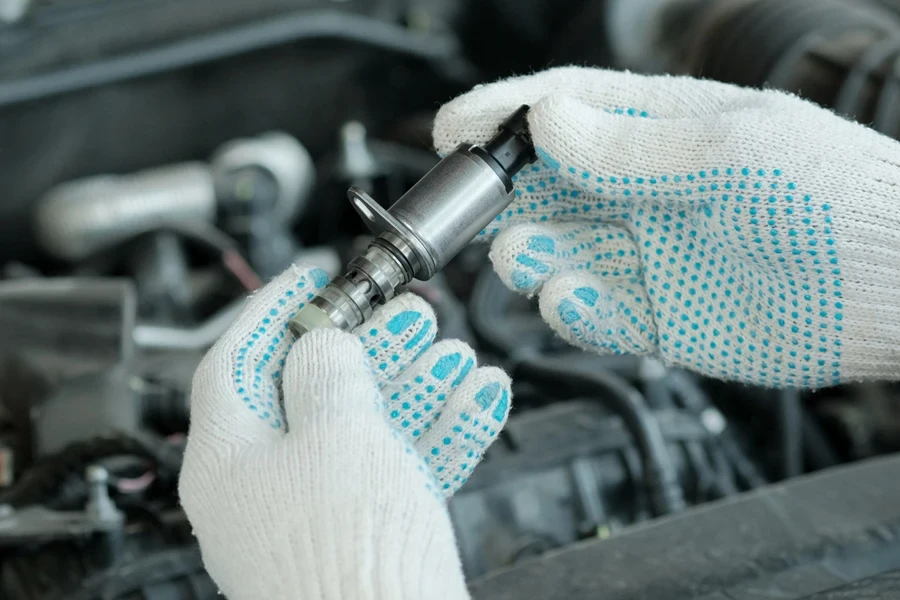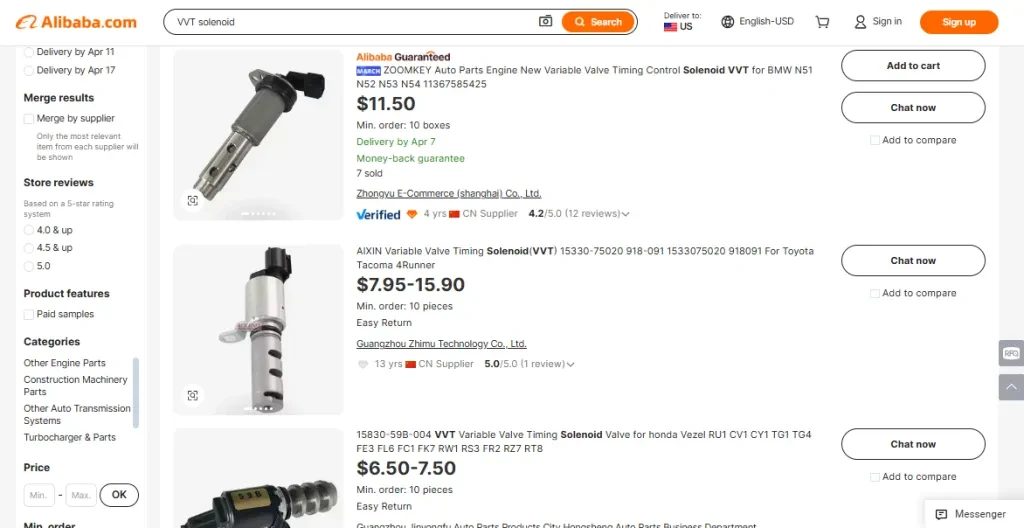Modern engines are all about flexibility – one second, drivers want maximum fuel economy; the next, they might be merging onto a busy interstate and need that extra speed. Variable valve timing (VVT) technology was developed to handle exactly that: adjusting the timing of engine valves on the fly to achieve a nice blend of efficiency and power.
The VVT solenoid, a small valve, helps move oil around and strategically shifts the car’s camshaft position to optimize your engine’s power delivery. As with most components, solenoids aren’t immune to wear and tear. And while most consumers may never have heard of the VVT solenoid, they will undoubtedly know once it starts acting up.
Read on to discover everything you need to know about VVT solenoids and which ones to stock for your business.
Table of Contents
What exactly does a VVT solenoid do?
How long does a VVT solenoid usually last?
6 signs it’s time to replace a VVT solenoid
1. The check engine light
2. Rough or unstable idling
3. Sluggish acceleration
4. Reduced fuel efficiency
5. Strange engine noises
6. Oil-related problems or gunk
What auto retailers should consider when stocking VVT solenoid replacements
1. Figuring out which vehicles matter most
2. Build quality and materials
3. Electrical connector fitment
In conclusion
What exactly does a VVT solenoid do?

As mentioned earlier, a variable valve timing solenoid is a small, electronically controlled valve that manages oil flow in a vehicle’s camshaft system. Here’s what you need to know about how they work:
- It’s located in the cylinder head: You’ll usually find it mounted near the top of the engine, where it can easily control oil going to the camshaft phaser (also known as the actuator)
- It responds to signals from the car’s computer: The engine control unit (ECU) or powertrain control module (PCM) sends the solenoid a digital “command.” The solenoid then opens or closes specific channels, letting more or less oil reach the camshaft.
- It adjusts valve timing: By altering the camshaft’s position or “phase,” the engine can precisely adjust when each valve opens and closes. This is crucial for balancing fuel efficiency, emissions, and torque.
Kitchen sink faucets provide a handy analogy. Turn the knob one way, and the flow of water (or, in this case, oil) increases; turn it another way, and it slows down. The difference is that the solenoid’s “knob” is controlled by electronic impulses instead of your hand.

How long does a VVT solenoid usually last?
There’s no absolute expiration date on these parts, but most well-made VVT solenoids can go anywhere from 60,000 to 100,000 miles (or even more) before giving up the ghost. That’s assuming consumers undertake regular maintenance and have decent driving habits.
Some factors that influence this lifespan include:
- Driving style and environment: Constant stop-and-go city traffic, extreme heat, or dusty conditions can stress the engine, affecting the VVT solenoid. Plus, if consumers are into performance cars (and they drive them aggressively), their VVT solenoid might wear out sooner.
- Oil quality and maintenance: The solenoid relies on oil. So, if it’s reasonably clean and at the proper viscosity, the component will last longer. But if drivers neglect oil changes or use the wrong oil, it will build up sludge and clog the solenoid’s tiny passages.

In short, you can think of the solenoid as a “high-mileage” part, but that doesn’t mean it’s damage-proof. Once wear or contamination sets in, the driver’s engine will give them subtle (and sometimes not-so-subtle) hints that it’s time for a swap.
6 signs it’s time to replace a VVT solenoid

There’s a good chance consumers will ask: “How do I know it’s time to get a VVT solenoid replacement?” Here are six clues that often point to a failing VVT solenoid:
1. The check engine light
Today’s cars are pretty good at self-diagnosis. If the onboard computer detects that the valve timing is off, it will activate the check engine light and register a trouble code, such as P0010, P0011, P0012, or a similar code.
2. Rough or unstable idling
One of the perks of proper valve timing is a smooth idle. So, if the engine starts to shake, stumble, or act like it’s about to malfunction at stoplights, that might mean the VVT system is allowing excess oil to enter the gears.
3. Sluggish acceleration
If consumers notice their engine is losing some power or the car just doesn’t “kick” into gear like it used to, it can be a sign that the engine isn’t getting enough power. A failing VVT solenoid won’t adjust the timing correctly, leading to reduced engine power.

4. Reduced fuel efficiency
An engine may lose power and burn more fuel if something is wrong with the VVT system. If a driver notices spending a lot more time at the gas pump without an apparent reason, such as towing or new tires, the VVT system may be stuck in the wrong timing phase, preventing the engine from achieving the correct air-fuel mix.
5. Strange engine noises
Sometimes, a failing solenoid can cause rattling, ticking, or knocking sounds, particularly when the engine is idling or first starting up. This may happen because the solenoid isn’t providing enough oil pressure to the VVT actuator, which won’t keep the engine timing in sync. While many possible causes for odd engine noises exist, VVT troubles are pretty standard.
6. Oil-related problems or gunk
A faulty engine might be the result of oil clogging the VVT solenoid. If cleaning the solenoid and changing the oil doesn’t fix the issue, replacing the solenoid may be the next best option.
None of these signs alone is a guarantee, but they’re a reliable warning that something is up. A thorough diagnostic, including scanning error codes and physically inspecting the part, can help consumers confirm if it’s time for a replacement.
What auto retailers should consider when stocking VVT solenoid replacements
1. Figuring out which vehicles matter most

Certain regions have a higher concentration of specific car brands. If Toyotas dominate their local roads, retailers will likely see more requests for Toyota-compatible VVT solenoids. However, if they see many European cars, focusing on VW, Audi, and BMW variants would be a good starting point. Sometimes, talking with local repair shops reveals which makes and models most often have VVT issues. That knowledge can guide which solenoids retailers carry in bulk.
2. Build quality and materials
The VVT solenoid is too important not to care about build quality and materials. Stocking options with poor build quality and subpar materials can lead to serious issues, including engine performance problems, oil leaks, and premature failure. Hence, businesses must always opt for VVT solenoids with high-quality construction and materials.
More importantly, a high-quality solenoid made from robust metal alloys will last longer than one made from cheap plastic. Whether retailers stock OEM or high-quality aftermarket solenoids, they should opt for models that can easily withstand the stress of high temperatures and oil pressure fluctuations.
Extra note: A well-built solenoid will have precision machine components that allow smooth oil flow. This means no annoying oil leaks caused by inferior seals and gaskets.
3. Electrical connector fitment

A VVT solenoid won’t work correctly if the electrical connector doesn’t fit properly. For this reason, the model must match the consumer’s OEM connector (same pin design and placement). Businesses must also include the part number in their product title and description so that consumers can easily identify the correct one at a glance.
Another strategy retailers can use to make consumers’ lives easier is letting them search based on their car’s year, make, model, and engine size. This helps them find compatible solenoids, as some engines require specific models, even if the part fits the car model.
Pro tip: Never rely on “universal fit claims.” Verifying compatibility before purchasing is best achieved by checking specifications, ordering samples, and cross-referencing them with parts numbers. Remember that reputable suppliers give detailed specs on pin configurations and connector types.
In conclusion
VVT solenoids are crucial components of gasoline-powered vehicles. They help the engine’s valves open and close precisely when needed, leading to better engine performance and fuel efficiency. There’s also solid demand for replacements, as a failing one can make the driving experience less than ideal. Therefore, when drivers seek a solution, businesses must be prepared to offer them reliable replacements that address the issue and keep them satisfied for years to come.




